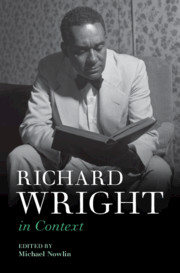Book contents
- Richard Wright in Context
- Richard Wright in Context
- Copyright page
- Contents
- Figures
- Contributors
- Abbreviations
- Richard Wright’s Works: A Chronology
- Introduction Richard Wright’s Luck
- Part I Life and Career, Times and Places
- Part II Social and Cultural Contexts
- Chapter 6 Black Masculinity
- Chapter 7 Wright and African American Women
- Chapter 8 He Tried to Be a Communist
- Chapter 9 Liberalism and the Color Line
- Chapter 10 “The Same Stuff”
- Chapter 11 Moviegoers and Cinematic Seers in Wright’s Fiction
- Chapter 12 Clothing
- Chapter 13 “Defeat Measured in the Jumping Cadences of Triumph”
- Chapter 14 Wright and Religion
- Chapter 15 Bandung and Third-World Liberation
- Chapter 16 Black Paris, Hard-Boiled Paranoia, and the Cultural Cold War
- Part III Literary and Intellectual Contexts
- Part IV Reputation and Critical Reception
- Index
Chapter 14 - Wright and Religion
from Part II - Social and Cultural Contexts
Published online by Cambridge University Press: 08 July 2021
- Richard Wright in Context
- Richard Wright in Context
- Copyright page
- Contents
- Figures
- Contributors
- Abbreviations
- Richard Wright’s Works: A Chronology
- Introduction Richard Wright’s Luck
- Part I Life and Career, Times and Places
- Part II Social and Cultural Contexts
- Chapter 6 Black Masculinity
- Chapter 7 Wright and African American Women
- Chapter 8 He Tried to Be a Communist
- Chapter 9 Liberalism and the Color Line
- Chapter 10 “The Same Stuff”
- Chapter 11 Moviegoers and Cinematic Seers in Wright’s Fiction
- Chapter 12 Clothing
- Chapter 13 “Defeat Measured in the Jumping Cadences of Triumph”
- Chapter 14 Wright and Religion
- Chapter 15 Bandung and Third-World Liberation
- Chapter 16 Black Paris, Hard-Boiled Paranoia, and the Cultural Cold War
- Part III Literary and Intellectual Contexts
- Part IV Reputation and Critical Reception
- Index
Summary
Most scholarship on Richard Wright places him as one of the key representatives of atheism and secularism in the history of 20th century African American letters. This representation consequently reduces and overlooks much of the nuances Wright’s thoughts on religion. This chapter highlights that Wright recognized two contrasting thoughts that serve as the foundation of his thinking about religion: the significance of religion for poor Black adherents and the insufficiency of any religion for Black devotees in the context of a white supremacist world. Since this complication reappears throughout his oeuvre, this chapter seeks to provide a general portrait of Wright’s overlooked thoughts on religion—while also limiting my judgments of those thoughts—in order to contextualize how his work fits in mid-twentieth-century Black religious discourse.
- Type
- Chapter
- Information
- Richard Wright in Context , pp. 150 - 160Publisher: Cambridge University PressPrint publication year: 2021

